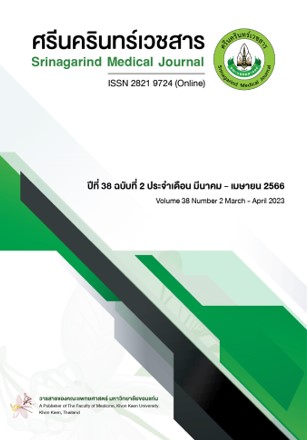Development of Autoverification System for Complete Blood Count (CBC) Analysis
Keywords:
autoverification (AV) system, complete blood count (CBC), laboratory, turnaround timeAbstract
Background and Objective: The complete blood count (CBC) is the most common test in the laboratory. A lot of patients and many steps in the process lead to more staff stress and turnaround time (TAT). This study aimed to set and investigate the parameters of an autoverification (AV) system to improve the efficiency and reduce TAT.
Method: This study was conducted at diagnostic microscopic laboratory, Srinagarind Hospital, Faculty of Medicine, Khon Kaen University. Set up the AV rules. Evaluate the resulting of AV rules by comparing the AV results to the 200 manually slide blood smear tests. Compare TAT at before and after AV implementation.
Results: False negative was 0.5 %, 2.5 %, 1.0 % for parameter WBC, RBC and platelet, respectively. After the implementation AV passing rate was 42.8 %, the means TAT was decreased from 43.7 to 34.2 min in routine case and from 37.0 to 33.3 min in emergency case.
Conclusion: The AV system can not only reduce the TAT but also increase the lab working efficiency by applying the appropriate rules. In the future, the system efficiency could be continuously improved by a new knowledge and high technology.
References
Riben M. Laboratory automation and middleware. Surg Pathol Clin 2015;8(2):175-86. doi.org/10.1016/j.path.2015.02.012
Angeletti S, De Cesaris M, Hart JG, Urbano M, Vitali MA, Fragliasso F, et al. Laboratory automation and intralaboratory turnaround time: experience at the University Hospital Campus Bio-Medico of Rome. J Lab Autom 2015;20(6):652-8. doi.org/10.1177/2211068214566458
Jensen K, Haniff R, Kamarinos A, Rosenberg A, Santiago M, Laser J. Improving turnaround times through a process improvement initiative involving barcoding, floorplans, dual measuring cells, chemistry analyzers, and staff shifts. J Appl Lab Med 2019;4(3):311-22. doi.org/10.1373/jalm.2018.028555
Krasowski MD, Davis SR, Drees D, Morris C, Kulhavy J, Crone C, et al. Autoverification in a core clinical chemistry laboratory at an academic medical center. J Pathol Inf 2014;5(13):1-17. doi.org/10.4103/2153-3539.129450
Wu J, Pan M, Ouyang H, Yang Z, Zhang Q, Cai Y. Establishing and evaluating autoverification rules with intelligent guidelines for arterial blood gas analysis in a clinical laboratory. SLAS Technol 2018;23(6):631-40. doi.org/10.1177/2472630318775311
Mlinaric A, Milos M, Coen Herak D, Fucek M, Rimac V, Zadro R, et al. Autovalidation and automation of the postanalytical phase of routine hematology and coagulation analyses in a university hospital laboratory. Clin Chem Lab Med 2018;56(3):454-62. doi.org/10.1515/cclm-2017-0402
Jin D, Wang Q, Peng D, Wang J, Li B, Cheng Y, et al. Development and implementation of an LIS-based validation system for autoverification toward zero defects in the automated reporting of laboratory test results. BMC Med Inf Decis Mak 2021;21:174. doi.org/10.1186/s12911-021-01545-3
Barnes PW, McFadden SL, Machin SJ, Simson E. The international consensus group for hematology review: suggested criteria for action following automated CBC and WBC differential analysis. Lab Hematol 2005;11:83-90. doi.org/10.1532/LH96.05019
Sysmex corperation. XN series (XN-9000/XN-9100) Instructions for Use. Japan: KOBE: Sysmex Coperation KOBE; 2017.
Nuanin S, Tientadakul P, Reesukumal K. Autoverification improved process efficiency, reduced staff workload, and enhanced staff satisfaction using a critical path for result validation. Siriraj Med J 2020;72(4):296-306. doi.org/10.33192/Smj.2020.40
Kazezoglu C. Investigation of the effect of autoverification on hematology laboratory workflow. Int J Med Biochem 2021;4(1):19-24.
Martinez-Nieto O, Lozano-Gaitán A, Beltrán-Diaz P, Ivan Leonardo Mojica-Figueroa, Morales-Reyes OL, Isaza-Ruget MA. Autoverification of the automated blood cell counter (CBC) in a reference laboratory in Bogota, Colombia. J Bras Patol Med Lab 2015;51(6):369-75. doi.org/10.5935/1676-2444.20150058
Zhao X, Wang XF, Wang JB, Lu XJ, Zhao YW, Li CB, et al. Multicenter study of autoverification methods of hematology analysis. J Biol Regul Homeost Agents 2016;30:571-7.
Fu Q, Ye C, Han B, Zhan X, Chen K, Huang F, et al. Designing and validating autoverification rules for hematology analysis in Sysmex XN-9000 hematology system. Clin Lab 2020;66(4):e190726 doi.org/10.7754/Clin.Lab.2019.190726
Chaibunruang A, Sornkayasit K, Chewasateanchai M, Sanugul P, Fucharoen G, Fucharoen S. Prevalence of thalassemia among newborns: a re-visited after 20 Years of a prevention and control program in northeast Thailand. Mediterr J Hematol Infect Dis 2018;10:e2018054. doi.org/10.4084/mjhid.2018.054
Fucharoen G, Fucharoen S, Sanchaisuriya K, Sae-Ung N, Suyasunanond U, Sriwilai P, et al. Frequency distribution and haplotypic heterogeneity of ßE-globin gene among eight minority groups of northeast Thailand. Hum Hered 2002;53:18-22. doi.org/10.1159/000048600
Pratumvinit B, Wongkrajang P, Reesukumal K, Klinbua C, Niamjoy P. Validation and optimization of criteria for manual smear review following automated blood cell analysis in a large university hospital. Arch Pathol Lab Med 2013;137(3):408-14. doi.org/10.5858/arpa.2011-0535-OA
Downloads
Published
How to Cite
Issue
Section
License
Copyright (c) 2023 Srinagarind Medical Journal

This work is licensed under a Creative Commons Attribution-NonCommercial-NoDerivatives 4.0 International License.




